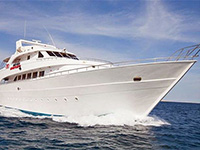
Photo copyright Tim Nicholson.
Marble ray (Taeniura meyeni) Madivanu Outer Reef (Lhaviyani Atoll), Maldives
The first thing you notice about the Marble Ray is its great size. It can be 3 m (10 ft) in length and 1.7 m (6 ft) wide. Round in shape it is covered with a dense pattern of black spots. It is not aggressive but you need to be careful of the spines on the tail.
The Marble Ray bears live young: the eggs are kept in the body of the female where the embryo develops. Up to seven pups hatch from the egg capsules and are born soon afterwards.
The ray is classified as "vulnerable" on the IUCN Red List of Threatened Species. This means that it is at high risk of endangerment in the wild.
Although Australia and the Maldives protect the ray through marine parks and prohibiting the export of rays and ray products, elsewhere the species is caught by line gear and trawl throughout its range. For example, in Indonesia Taeniura meyeni is regularly taken in low numbers by tangle netters operating out of Jakarta (Java), Bali and Merauke (West Papua), while demersal longliners that operate out of Lombok and large pair trawlers operating out of Merauke irregularly take adults. The latter fishery comprises some 650 vessels and pressure is intense where the vessels operate in the Arafura Sea. Low numbers of juveniles are also taken by prawn and fish trawlers around Indonesia, particularly in the Java Sea.
Overall, fishing pressure is significant over most of the species' range throughout Asia and across its Indian Ocean range (India, East Africa etc). Additional pressure exists on its habitat in that region due to destructive fishing practices (dynamite fishing) and run-off impacting coral reef systems, the main habitat of the species.
The Marble Ray has many names, including two scientific ones: Taeniura meyeni and T. melanospilos. Its common names include Black-spotted stingray, Giant reef ray, Marbled ray, Blotched fantail ray and Round ribbontail ray.
Native to: Australia; Bangladesh; Cambodia; China; Cook Islands; Djibouti; Ecuador (Galapagos); Egypt; Eritrea; Ethiopia; India; Indonesia; Iran; Iraq; Japan; Kenya; Korea; Kuwait; Madagascar; Malaysia; Maldives; Mauritius; Micronesia; Mozambique; Myanmar; New Caledonia; Oman; Pakistan; Papua New Guinea; Philippines; Qatar; Saudi Arabia; Seychelles; Singapore; Somalia; South Africa; Sri Lanka; Sudan; Taiwan, Tanzania; Thailand; Timor-Leste; United Arab Emirates; Vanuatu; Viet Nam; Yemen
Back to Maldives Photo Gallery
Notes on diving the Maldives...
Further Reading
Coral Reef Fishes, Indo-Pacific and Caribbean
, by Ewald Lieske and Robert Myers, Harper Collins
Kyne, P.M. & White, W.T. 2006. Taeniura meyeni. In: IUCN 2009. IUCN Red List of Threatened Species. Version 2009.2.
Atlas of the Maldives: A Reference for Travellers, Divers and Sailors, by Tim Godfrey,(2007)
The Underwater Photographer: Digital and Traditional Techniques by Martin Edge, Paperback, 536 pages (2009)





